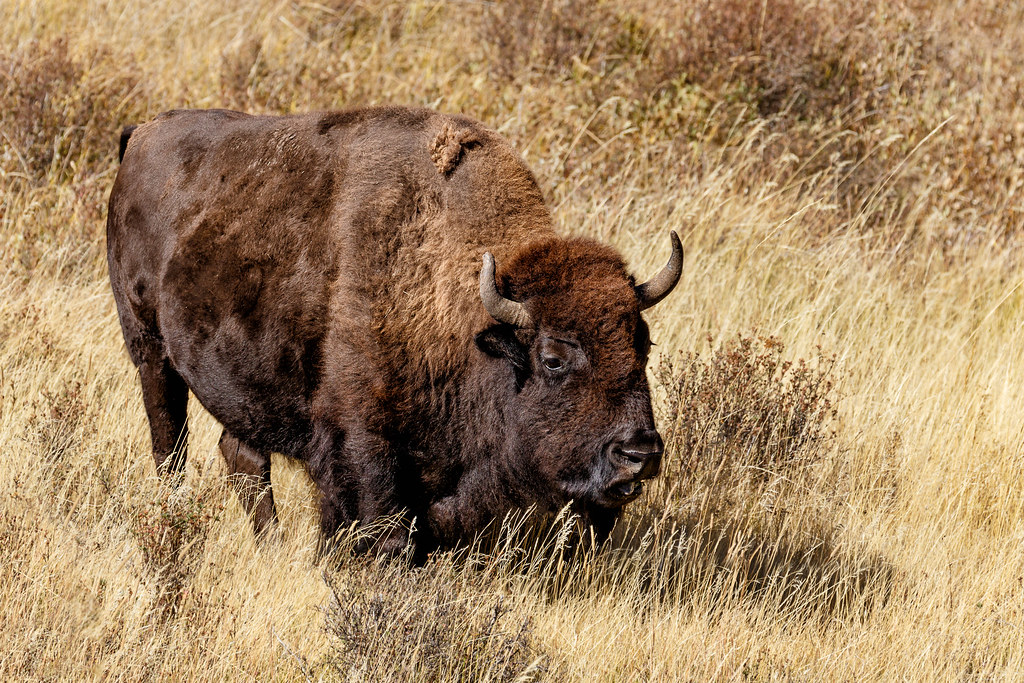#blacktail deer plateau
Photo
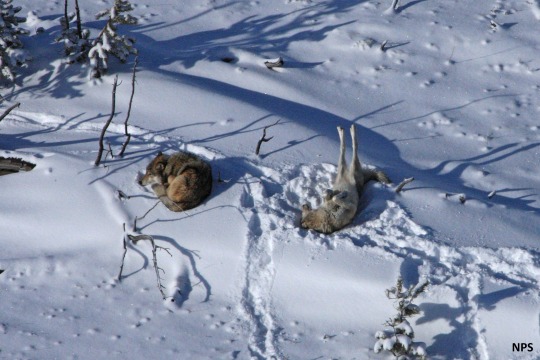
Source
#wolf#wolves#wildlife#nature#animals#blacktail deer plateau pack#winter#blacktail deer plateau#snow#rolling#roll#stretch#stretching#curled up#resting#laying
814 notes
·
View notes
Link
This is a good story about wolves reintroducing themselves and settling in in the State of California. Under California law, wolves are protected, and the penalties for killing them are substantial (a fine of $100,000 and prison time). So, wolves will arrive and mostly survive, as opposed to what happens to them under the barbaric laws and customs of states like Wisconsin, Montana and Idaho.
A clip of wolves new to California, settling in, with the pups:
youtube
Excerpt from this story from Smithsonian:
At a steady trot, wolves can go 20 miles without breaking stride and cover 50 miles in a day. Their long thin legs move with the inevitability of bicycle wheels, with the rear foot landing in the exact spot just vacated by the front foot and the rest of the wolf flowing along. They travel with a look of intense purpose—ears pricked up, eyes keen, nostrils sifting the air for information—yet their movement over the land appears effortless.
The female gray wolf that biologists would call LAS01F was born somewhere in the Northern Rockies in 2014, possibly in Wyoming. In her second year of life, coursing with hormones, she left her natal pack to find a mate and a territory of her own, and kept going for another 800 miles or more.
She either crossed the Great Basin Desert in Utah and Nevada, or she made a much longer journey through Idaho and Oregon. Whichever passage she took, she was hunting by herself for the first time in unfamiliar terrain, learning to find water, cross roads, stay hidden from human beings.
At regular intervals she would have scent-marked her trail so other wolves, and preferably an unattached male, might find her. She would have howled often, listened carefully, and if she journeyed across the Great Basin—heard nothing in response. As far as we know, there were no other wolves in that vast stretch of ground.
It’s difficult to say why this particular female made such an epic journey. A small minority of wolves are long-distance travelers, and no one really knows why. It’s probably best understood as a personality trait; there is some evidence that the behavior may run in families.
After traveling for at least a month, and perhaps longer, she reached the forested mountains of northeast California. There was clean water in the streams, blacktail and mule deer to hunt, a few elk, not too many humans, and features in the landscape that gray wolves find appealing: high plateaus, forested ridges, meadows. There were also thousands of cattle and sheep. We might say she was recolonizing ancestral ground, for it was here in Lassen County that the last wild wolf in California was shot and killed, in 1924, as part of the centuries-long extermination campaign that nearly wiped out wolves in the lower 48.
17 notes
·
View notes
Video
American Bison by Tim Lumley
Via Flickr:
Bison grazing along the Grand Loop Road in the north end of the park near the Blacktail Deer Plateau. Blacktail Deer Plateau, Yellowstone National Park, Wyoming. USA. Elevation: 6,690 ft., September 20, 2015.
#American bison#Bison bison#USA#United States#WY#Wyoming#YNP#Yellowstone National Park#animal#buffalo#mammal#meadow#national park#park#prairie#wildlife#nature
3 notes
·
View notes
Photo

Bison at sunrise, Blacktail Deer Plateau
NPS/Neal Herbert
142 notes
·
View notes
Photo



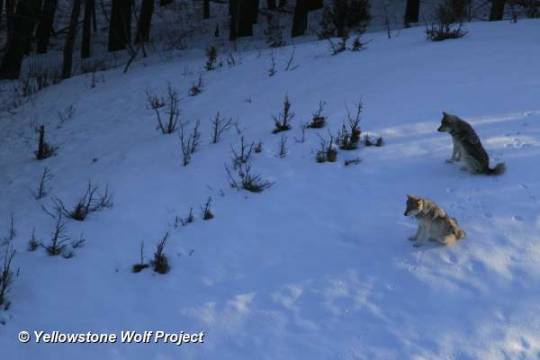
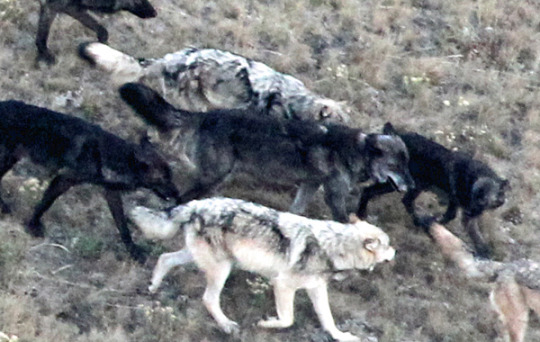





8 Mile Pack- The 8 Mile pack originated in southwest Montana and was named after a creek in Paradise Valley. Montana Fish, Wildlife & Parks radio-collared a large black male (SW763M) from this pack near Tom Miner Basin (SW denotes southwest Montana). This pack was considered a boundary pack until 2011 when the alpha female denned within the park boundary, in Sepulcher Hills, for the first time. While establishing itself as a park pack, 8 Mile displaced the Quadrant Mountain pack and had multiple interactions with the Blacktail Deer Plateau pack. The pack’s first documented alpha male, 871M, was radio-collared in February 2013, and led the pack with alpha female 909F (“Red/Brown”), until he was killed by a neighboring pack in October of 2014. This pack often splits into smaller groups, but together, total 17 wolves. 963F, a former breeding female, appears to have left 8 Mile for a Montana pack. But, 2018 still seems to be a successful breeding year for this pack with probably two active dens. In the winter of 2018/2019, 8 Mile had many new male members from the Wapiti Lake pack, including: 1105M, 1106M, 1015M, and a few uncollared wolves. They seemed to have driven off the aging alpha male 962M, who was later harvested legally in Montana north of the park. Around that time, 1005F, 1119F, and 1049F split off of the main 8 Mile group and started utilizing the area between Blacktail Plateau and Hellroaring. They briefly merged with Crevice Lake pack, but it didn't last. It will be interesting to see which 8 Mile group dens and if we have a new pack forming!
149 notes
·
View notes
Photo
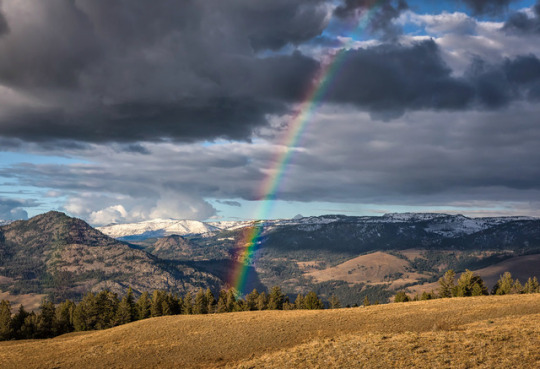
Yellowstone Rainbow by Phil's Pixels on Flickr
A rainbow appeared, adding to the beauty of driving Yellowstone's Blacktail Deer Plateau road.
1 note
·
View note
Video
Bison on Blacktail Deer Plateau by Yellowstone National Park
Via Flickr:
NPS/Diane Renkin
1 note
·
View note
Photo

Hi Michael,
I have recently stumbled onto your site and have been enjoying it very much. My husband and I are planning a trip to Yellowstone in a few weeks. We’d like to take in a few short hikes. We are both in our late 60s and in decent shape. We spent a few days in Arches this spring and took a few five-mile hikes through the park and enjoyed it thoroughly. What hike could you recommend for us? We are thinking about limiting our hikes to fives miles because of the change in elevation/terrain and weather conditions we may encounter there.
Thank you.
Jeanne
Strafford, N.H.
Hi Jeanne,
Thanks for writing and finding The Big Outside. You are heading to a fantastic park for short walks and hikes any time of year, although I think autumn is ideal because of good weather and fewer people; some of the photos in this story were shot on an October trip I took.
You should read my “Ultimate Family Tour of Yellowstone” for ideas on the best spots to visit and take very short walks while driving through the park, including the Midway Geyser Basin and America’s largest hot spring, Grand Prismatic.
Grand Prismatic Spring, Midway Geyser Basin, Yellowstone.
As for hikes of five miles and under, here are the ones I’d suggest, listed in no particular order.
Bunsen Peak
The summit of 8,564-foot Bunsen Peak, about five miles south of Mammoth Hot Springs, overlooks a huge swath of the park, from the Gallatin Range to the west, across the high plateau that comprises much of Yellowstone, to the Beartooth and Absaroka Mountains. The round-trip hike on the Bunsen Peak Trail is four miles.
Lamar River Valley
The Lamar River Valley in the park’s northeast corner is a great area for seeing wildlife like bison and elk and occasionally wolves. Hike out and back as far as you want on the Lamar River Trail, which is pretty flat and passes through open terrain with big views.
Hi, I’m Michael Lanza, creator of The Big Outside, which has made several top outdoors blog lists. Click here to sign up for my FREE email newsletter, or enter your email address in the box in the left sidebar or at the bottom of this story. Click here to get full access to all of my blog’s stories. Follow my adventures on Facebook, Twitter, Instagram, and Youtube.
View from near the summit of 10,243-foot Mount Washburn.
Mount Washburn
Mount Washburn is 6.2 miles out-and-back from Dunraven Pass on the Grand Loop Road; there’s a shorter, five-mile out-and-back to the summit from a trailhead on a dirt road just north of Washburn, that ascends more than 1,700 feet. The views from 10,243-foot Washburn take in the Tetons, Beartooth and Absaroka Mountains, and the Madison Range. The Indian paintbrush, lupine, and other wildflowers bloom in late July and early August. Hike it in early morning or evening for a good chance of seeing bighorn sheep.
View of Grand Canyon of the Yellowstone River from Lookout Point, North Rim Trail.
North Rim Trail, Grand Canyon of the Yellowstone
The North Rim Trail along the rim of the Grand Canyon of the Yellowstone River (lead photo at top of story) is arguably the park’s most scenic walk, with constant views into the deep canyon, including Lower Yellowstone Falls. (In fact, I put it on my list of the best national park dayhikes in the country.) Various points of road access allow you to choose a hiking distance, but the entire trail is fairly flat and under four miles. You can also walk across a bridge past Upper Yellowstone Falls to reach the south rim and make it a longer hike by following the South Rim Trail for the views from the other side.
Gear up right for hikes in Yellowstone. See my reviews of the best hiking shoes and the 7 best daypacks.
Uncle Tom’s Trail, Grand Canyon of the Yellowstone
The Uncle Tom’s Trail on the south rim of the Grand Canyon of the Yellowstone River is short—it only descends about 500 feet—but the metal stairs you follow down it lead to a spectacular viewpoint near the base of Lower Yellowstone Falls.
Fairy Falls
The Fairy Falls Trail, in the Midway Geyser Basin, leads to one of the park’s nicest waterfalls, 197-foot Fairy Falls, passing views of the park’s biggest and most colorful geyser, Grand Prismatic Geyser. There are a couple ways to get there, both fairly flat. The shorter route, five miles round-trip, begins a mile south of Midway Geyser Basin, where you cross a steel bridge. The longer route of eight miles round-trip begins at the parking area at the end of Fountain Flat Drive. From the falls, you can continue 0.6 mile one-way to Spray and Imperial geysers, and then double back.
Stay dry and happy. See my reviews of “The 5 Best Rain Jackets For the Backcountry.”
Old Faithful, Upper Geyser Basin.
Upper Geyser Basin
The Upper Geyser Basin is home to the world’s largest concentration of geysers, hundreds of them, including Old Faithful. You can walk the almost flat trail and boardwalk for several miles from Geyser Hill to Biscuit Basin and Black Sand Basin, or take a shorter tour. Get a map and guide to the Upper Geyser Basin and take time to explore it. You don’t want to miss this area.
The Big Outside helps you find the best adventures. Subscribe now to read ALL stories and get a free e-guide!
Mammoth Hot Springs, Yellowstone.
Mammoth Hot Springs
Mammoth Hot Springs, multi-hued travertine terraces formed by thermal waters rising through limestone, is unquestionably one of the most inspiring areas of the park. Water constantly pools and trickles down the terraces and steam billows from them. Boardwalks weave through the lower terraces and a one-way loop road through the upper terraces. Plan to explore this area for an hour or more of leisurely walking for the dramatic light of early morning.
Lone Star Geyser
The Lone Star Geyser Trail, which begins near Kepler Cascades, just south of Old Faithful, is an almost five-mile round-trip hike to Lone Star Geyser, which is several feet tall and erupts about every three hours. Go early in the morning to avoid the crowds and give yourself time to sit and wait for the geyser to blow.
Read about how climate change is affecting Yellowstone and other parks in my book
Before They’re Gone—A Family’s Year-Long Quest to Explore America’s Most Endangered National Parks.
Along the Blacktail Deer Creek Trail, Yellowstone National Park.
Blacktail Deer Creek Trail
The Blacktail Deer Creek Trail, which begins about 6.7 miles east of Mammoth on the Grand Loop Road, winds north across gently rolling grasslands and meadows with long views of partly forested hills and a good chance of seeing a bison herd. The trail drops more than 1,000 feet in 3.7 miles to the Black Canyon of the Yellowstone River, where, for a longer outing, you can hike either upriver or downriver along a trail through conifer forest, with views of the cliffs rising above the meandering river. But the first few miles of the Blacktail Deer Creek Trail are fairly easy, before it begins descending more steeply into the canyon, and you can turn back at any point.
See all of my stories about Yellowstone National Park, including “Photo Gallery: Yellowstone in Autumn,” and all of my stories about national park adventures at The Big Outside.
Good luck, thanks for writing.
Best,
Michael
I can help you plan the best backpacking, hiking, or family adventure of your life.
Got questions about hiking, backpacking, planning a family adventure, or any trip I’ve written about at The Big Outside? Email me at [email protected]. I’ll answer your questions to help ensure your trip is a success. See my Ask Me page for details.
—Michael Lanza
Tell me what you think.
I spent a lot of time writing this story, so if you enjoyed it, please consider giving it a share using one of the buttons below, and leave a comment or question at the bottom of this story. I’d really appreciate it.
0 notes
Photo

Leaping mule deer buck near the Blacktail Plateau. 🐺 OldWolfPhoto.com. 🐺 #nature #wildlife #animals #natgeo #bears #naturephotography #outdoorsphotography #wildlifephotography #yellowstone #yellowstonenationalpark #yellowstonenps #nanpapix #natgeo_wild_hd #bighornsheep #elk #deer #muledeer #bucks #foxes #coyotes #wolves #yellowstoneforever #pronghorn #wolf #dogs #pets #moose #petsofinstagram #nationalparks #whitetails https://ift.tt/2I0CbT4
0 notes
Text
When wolves were reintroduced in Yellowstone, some unexpected species benefitted.
<br>
On a quiet hike in Yellowstone National Park, some lucky visitors might get to hear an amazing sound: the howl of a gray wolf.
A wolf howling in the Lower Geyser Basin of Yellowstone National Park. Image by Jim Peaco/YellowstoneNPS.
They might even get to spot one of these beautiful animals darting across the landscape. In fact, today, the chances of seeing a wolf in some parts of this park — such as Lamar Valley — are so good that some people come just to wolf-watch.
A female wolf standing in a road near the Lamar River Bridge in Yellowstone National Park. Image by Jim Peaco/YellowstoneNPS.
But for most of the 20th century, it was impossible to view these animals at all inside the park.
In fact, it was hard to see a gray wolf anywhere in the lower 48 states. That is because ever since settlers moved west, they feared the great gray wolf. The fact that wolves started killing livestock didn’t help either.
So, starting in the late 1800s up until the 1920s, wolves were hunted and poisoned by ranchers and predator control programs in order to protect people, livestock, and other “more desirable” wildlife species. In the end, not a single breeding pair of wolves remained in Yellowstone National Park.
Soda Butte Creek in Yellowstone National Park in October 1993. Image by Jim Peaco/YellowstoneNPS.
When Yellowstone lost its wolves, it caused some big problems for the whole ecosystem.
Wolves are apex predators, which means they are at the top of the food web. When wolves were eliminated, it caused what scientists call a top-down trophic cascade. In other words, the whole ecosystem became unbalanced.
“Most ecosystems are best when they’re balanced,” Doug Smith, project leader for the Wolf Restoration Project in Yellowstone, said in a National Park Service Q&A. “Having a lot of different kinds of things at moderate numbers is better than having a lot of any one thing.”
Without wolves, there was a lot of one thing: elk. And biodiversity across the entire park declined as a result.
Two bull elk at Blacktail Deer Plateau. Image by Neal Herbert/YellowstoneNPS.
Why? Because without one of their major natural predators, fewer elk were dying. Their numbers grew so much that they ended up overgrazing large areas of land, leaving them vulnerable to erosion and defoliation.
This hurt plants and other animal species. Willow and aspen trees started dying off — and that hurt the species that relied on these trees for their survival, such as the birds that use them as nesting grounds and the beavers that use the wood to build dams and survive the winter.
The numbers of rabbits and mice species fell, too, because of all the overgrazing. They simply had fewer places to hide from predators.
Everything started to change after scientists reintroduced 41 wolves into Yellowstone National Park.
A newly arrived wolf is released from its cage into a pen in 1996. Image by Jim Peaco/YellowstoneNPS.
From 1995 to 1997, wolves were captured in Canada and northwest Montana and transported to Yellowstone. Once there, each was radio-collared and temporarily penned so biologists could make sure they were healthy.
Then they were released into the wilderness of the park.
Park rangers prepare to release a wolf into the park in 1996. image by Jim Peaco/YellowstoneNPS.
The wolves thrived in their new home.
The newly formed packs spread out and established their territories, and the large populations of elk and deer provided them with ample prey. And because they were inside the national park, the animals were protected from hunters. So their numbers grew.
The Gibbon wolf pack in Yellowstone National Park. Image via Yellowstone/NPS.
Before long, the wolves started changing Yellowstone’s ecosystem all over again, but this time for the better.
The first thing that happened was the number of large prey dropped. In 1995, Yellowstone was home to about 18,000 elk, but by 2015, that number had dropped to 4,500, helping restore the ecosystem's natural balance.
Elk on Mount Everts in Yellowstone National Park in 2014. Image by Neal Herbert/YellowstoneNPS.
Scientists think this happened, at least in part, because wolves started to change their prey’s behavior. Deer and elk started avoiding areas where they could be easily hunted, such as open valleys and gorges, which caused those areas to regenerate. Plants started growing on the riverbanks and erosion decreased, causing rivers and streams to actually change course.
Meanwhile, birds, beavers, mice, and bears started returning to those once-barren areas.
A western meadowlark in Lamar Valley in the spring of 2015. Image by Neal Herbert/YellowstoneNPS.
The landscape of the whole park transformed, and the ecosystem as a whole became healthier.
A grizzly bear and her cub. Image by Jim Peaco/YellowstoneNPS.
Because they are carnivores, wolves often get a bad rap — but the Yellowstone story shows just how important they are to our planet.
The ecosystem in Yellowstone is complex and always changing, but recent history has shown scientists and ecologists how important wolves are to keeping the natural balance. It is true that wolves hunt large animals, but they are not just killers — they also help other species thrive.
A wolf from the Canyon pack in Yellowstone. Image by Diane Renkin/NPS.
We all know the story about the “the big bad wolf.” But today, Yellowstone National Park is helping us learn a different story about wolves, and this is one is a lot happier.
<br>
0 notes
Text
When wolves were reintroduced in Yellowstone, some unexpected species benefitted.
<br>
On a quiet hike in Yellowstone National Park, some lucky visitors might get to hear an amazing sound: the howl of a gray wolf.
A wolf howling in the Lower Geyser Basin of Yellowstone National Park. Image by Jim Peaco/YellowstoneNPS.
They might even get to spot one of these beautiful animals darting across the landscape. In fact, today, the chances of seeing a wolf in some parts of this park — such as Lamar Valley — are so good that some people come just to wolf-watch.
A female wolf standing in a road near the Lamar River Bridge in Yellowstone National Park. Image by Jim Peaco/YellowstoneNPS.
But for most of the 20th century, it was impossible to view these animals at all inside the park.
In fact, it was hard to see a gray wolf anywhere in the lower 48 states. That is because ever since settlers moved west, they feared the great gray wolf. The fact that wolves started killing livestock didn’t help either.
So, starting in the late 1800s up until the 1920s, wolves were hunted and poisoned by ranchers and predator control programs in order to protect people, livestock, and other “more desirable” wildlife species. In the end, not a single breeding pair of wolves remained in Yellowstone National Park.
Soda Butte Creek in Yellowstone National Park in October 1993. Image by Jim Peaco/YellowstoneNPS.
When Yellowstone lost its wolves, it caused some big problems for the whole ecosystem.
Wolves are apex predators, which means they are at the top of the food web. When wolves were eliminated, it caused what scientists call a top-down trophic cascade. In other words, the whole ecosystem became unbalanced.
“Most ecosystems are best when they’re balanced,” Doug Smith, project leader for the Wolf Restoration Project in Yellowstone, said in a National Park Service Q&A. “Having a lot of different kinds of things at moderate numbers is better than having a lot of any one thing.”
Without wolves, there was a lot of one thing: elk. And biodiversity across the entire park declined as a result.
Two bull elk at Blacktail Deer Plateau. Image by Neal Herbert/YellowstoneNPS.
Why? Because without one of their major natural predators, fewer elk were dying. Their numbers grew so much that they ended up overgrazing large areas of land, leaving them vulnerable to erosion and defoliation.
This hurt plants and other animal species. Willow and aspen trees started dying off — and that hurt the species that relied on these trees for their survival, such as the birds that use them as nesting grounds and the beavers that use the wood to build dams and survive the winter.
The numbers of rabbits and mice species fell, too, because of all the overgrazing. They simply had fewer places to hide from predators.
Everything started to change after scientists reintroduced 41 wolves into Yellowstone National Park.
A newly arrived wolf is released from its cage into a pen in 1996. Image by Jim Peaco/YellowstoneNPS.
From 1995 to 1997, wolves were captured in Canada and northwest Montana and transported to Yellowstone. Once there, each was radio-collared and temporarily penned so biologists could make sure they were healthy.
Then they were released into the wilderness of the park.
Park rangers prepare to release a wolf into the park in 1996. image by Jim Peaco/YellowstoneNPS.
The wolves thrived in their new home.
The newly formed packs spread out and established their territories, and the large populations of elk and deer provided them with ample prey. And because they were inside the national park, the animals were protected from hunters. So their numbers grew.
The Gibbon wolf pack in Yellowstone National Park. Image via Yellowstone/NPS.
Before long, the wolves started changing Yellowstone’s ecosystem all over again, but this time for the better.
The first thing that happened was the number of large prey dropped. In 1995, Yellowstone was home to about 18,000 elk, but by 2015, that number had dropped to 4,500, helping restore the ecosystem's natural balance.
Elk on Mount Everts in Yellowstone National Park in 2014. Image by Neal Herbert/YellowstoneNPS.
Scientists think this happened, at least in part, because wolves started to change their prey’s behavior. Deer and elk started avoiding areas where they could be easily hunted, such as open valleys and gorges, which caused those areas to regenerate. Plants started growing on the riverbanks and erosion decreased, causing rivers and streams to actually change course.
Meanwhile, birds, beavers, mice, and bears started returning to those once-barren areas.
A western meadowlark in Lamar Valley in the spring of 2015. Image by Neal Herbert/YellowstoneNPS.
The landscape of the whole park transformed, and the ecosystem as a whole became healthier.
A grizzly bear and her cub. Image by Jim Peaco/YellowstoneNPS.
Because they are carnivores, wolves often get a bad rap — but the Yellowstone story shows just how important they are to our planet.
The ecosystem in Yellowstone is complex and always changing, but recent history has shown scientists and ecologists how important wolves are to keeping the natural balance. It is true that wolves hunt large animals, but they are not just killers — they also help other species thrive.
A wolf from the Canyon pack in Yellowstone. Image by Diane Renkin/NPS.
We all know the story about the “the big bad wolf.” But today, Yellowstone National Park is helping us learn a different story about wolves, and this is one is a lot happier.
<br>
from Upworthy http://ift.tt/2necSWy
via cheap web hosting
0 notes
Photo

Saturday morning, early risers found the the Yellowstone River Valley inundated by fog where it passes along the Blacktail Deer Plateau in Yellowstone National Park.
Photo: National Park Service
#yellowstone national park#Wyoming#Blacktail Deer Plateau#Yellowstone River Valley#travel#hiking#nature#landscape#bestoftheday#picoftheday#photography#fog#love#like#america#public lands#national parks#beautiful#explore#adventure
444 notes
·
View notes
Photo
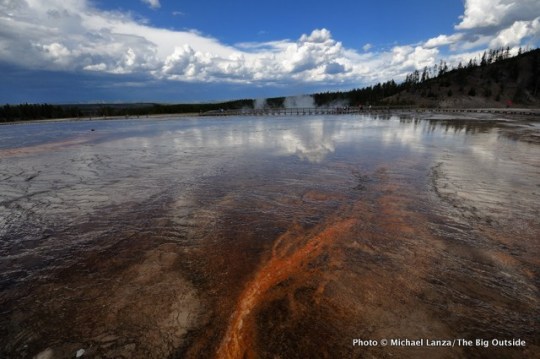
Hi Michael,
I have recently stumbled onto your site and have been enjoying it very much. My husband and I are planning a trip to Yellowstone in a few weeks. We’d like to take in a few short hikes. We are both in our late 60s and in decent shape. We spent a few days in Arches this spring and took a few five-mile hikes through the park and enjoyed it thoroughly. What hike could you recommend for us? We are thinking about limiting our hikes to fives miles because of the change in elevation/terrain and weather conditions we may encounter there.
Thank you.
Jeanne
Strafford, N.H.
Hi Jeanne,
Thanks for writing and finding The Big Outside. You are heading to a fantastic park for short walks and hikes any time of year, although I think autumn is ideal because of good weather and fewer people; some of the photos in this story were shot on an October trip I took.
You should read my “Ultimate Family Tour of Yellowstone” for ideas on the best spots to visit and take very short walks while driving through the park, including the Midway Geyser Basin and America’s largest hot spring, Grand Prismatic.
Grand Prismatic Spring, Midway Geyser Basin, Yellowstone.
As for hikes of five miles and under, here are the ones I’d suggest, listed in no particular order.
Bunsen Peak
The summit of 8,564-foot Bunsen Peak, about five miles south of Mammoth Hot Springs, overlooks a huge swath of the park, from the Gallatin Range to the west, across the high plateau that comprises much of Yellowstone, to the Beartooth and Absaroka Mountains. The round-trip hike on the Bunsen Peak Trail is four miles.
Lamar River Valley
The Lamar River Valley in the park’s northeast corner is a great area for seeing wildlife like bison and elk and occasionally wolves. Hike out and back as far as you want on the Lamar River Trail, which is pretty flat and passes through open terrain with big views.
Hi, I’m Michael Lanza, creator of The Big Outside, which has made several top outdoors blog lists. Click here to sign up for my FREE email newsletter, or enter your email address in the box in the left sidebar or at the bottom of this story. Click here to get full access to all of my blog’s stories. Follow my adventures on Facebook, Twitter, Instagram, and Youtube.
View from near the summit of 10,243-foot Mount Washburn.
Mount Washburn
Mount Washburn is 6.2 miles out-and-back from Dunraven Pass on the Grand Loop Road; there’s a shorter, five-mile out-and-back to the summit from a trailhead on a dirt road just north of Washburn, that ascends more than 1,700 feet. The views from 10,243-foot Washburn take in the Tetons, Beartooth and Absaroka Mountains, and the Madison Range. The Indian paintbrush, lupine, and other wildflowers bloom in late July and early August. Hike it in early morning or evening for a good chance of seeing bighorn sheep.
View of Grand Canyon of the Yellowstone River from Lookout Point, North Rim Trail.
North Rim Trail, Grand Canyon of the Yellowstone
The North Rim Trail along the rim of the Grand Canyon of the Yellowstone River (lead photo at top of story) is arguably the park’s most scenic walk, with constant views into the deep canyon, including Lower Yellowstone Falls. (In fact, I put it on my list of the best national park dayhikes in the country.) Various points of road access allow you to choose a hiking distance, but the entire trail is fairly flat and under four miles. You can also walk across a bridge past Upper Yellowstone Falls to reach the south rim and make it a longer hike by following the South Rim Trail for the views from the other side.
Gear up right for hikes in Yellowstone. See my reviews of the best hiking shoes and the 7 best daypacks.
Uncle Tom’s Trail, Grand Canyon of the Yellowstone
The Uncle Tom’s Trail on the south rim of the Grand Canyon of the Yellowstone River is short—it only descends about 500 feet—but the metal stairs you follow down it lead to a spectacular viewpoint near the base of Lower Yellowstone Falls.
Fairy Falls
The Fairy Falls Trail, in the Midway Geyser Basin, leads to one of the park’s nicest waterfalls, 197-foot Fairy Falls, passing views of the park’s biggest and most colorful geyser, Grand Prismatic Geyser. There are a couple ways to get there, both fairly flat. The shorter route, five miles round-trip, begins a mile south of Midway Geyser Basin, where you cross a steel bridge. The longer route of eight miles round-trip begins at the parking area at the end of Fountain Flat Drive. From the falls, you can continue 0.6 mile one-way to Spray and Imperial geysers, and then double back.
Stay dry and happy. See my reviews of “The 5 Best Rain Jackets For the Backcountry.”
Old Faithful, Upper Geyser Basin.
Upper Geyser Basin
The Upper Geyser Basin is home to the world’s largest concentration of geysers, hundreds of them, including Old Faithful. You can walk the almost flat trail and boardwalk for several miles from Geyser Hill to Biscuit Basin and Black Sand Basin, or take a shorter tour. Get a map and guide to the Upper Geyser Basin and take time to explore it. You don’t want to miss this area.
The Big Outside helps you find the best adventures. Subscribe now to read ALL stories and get a free e-guide!
Mammoth Hot Springs, Yellowstone.
Mammoth Hot Springs
Mammoth Hot Springs, multi-hued travertine terraces formed by thermal waters rising through limestone, is unquestionably one of the most inspiring areas of the park. Water constantly pools and trickles down the terraces and steam billows from them. Boardwalks weave through the lower terraces and a one-way loop road through the upper terraces. Plan to explore this area for an hour or more of leisurely walking for the dramatic light of early morning.
Lone Star Geyser
The Lone Star Geyser Trail, which begins near Kepler Cascades, just south of Old Faithful, is an almost five-mile round-trip hike to Lone Star Geyser, which is several feet tall and erupts about every three hours. Go early in the morning to avoid the crowds and give yourself time to sit and wait for the geyser to blow.
Read about how climate change is affecting Yellowstone and other parks in my book
Before They’re Gone—A Family’s Year-Long Quest to Explore America’s Most Endangered National Parks.
Along the Blacktail Deer Creek Trail, Yellowstone National Park.
Blacktail Deer Creek Trail
The Blacktail Deer Creek Trail, which begins about 6.7 miles east of Mammoth on the Grand Loop Road, winds north across gently rolling grasslands and meadows with long views of partly forested hills and a good chance of seeing a bison herd. The trail drops more than 1,000 feet in 3.7 miles to the Black Canyon of the Yellowstone River, where, for a longer outing, you can hike either upriver or downriver along a trail through conifer forest, with views of the cliffs rising above the meandering river. But the first few miles of the Blacktail Deer Creek Trail are fairly easy, before it begins descending more steeply into the canyon, and you can turn back at any point.
See all of my stories about Yellowstone National Park, including “Photo Gallery: Yellowstone in Autumn,” and all of my stories about national park adventures at The Big Outside.
Good luck, thanks for writing.
Best,
Michael
I can help you plan the best backpacking, hiking, or family adventure of your life.
Got questions about hiking, backpacking, planning a family adventure, or any trip I’ve written about at The Big Outside? Email me at [email protected]. I’ll answer your questions to help ensure your trip is a success. See my Ask Me page for details.
—Michael Lanza
Tell me what you think.
I spent a lot of time writing this story, so if you enjoyed it, please consider giving it a share using one of the buttons below, and leave a comment or question at the bottom of this story. I’d really appreciate it.
0 notes
Photo
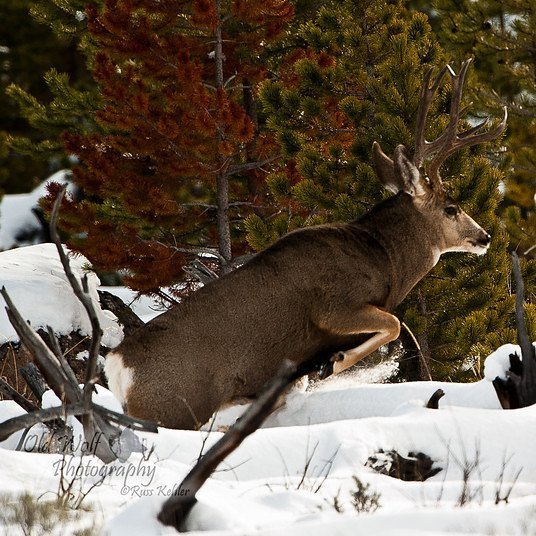
Blacktail buck. This splendid buck came flying through the snow, bounding over the rocks and fallen spruce trees, throwing showers of snow into the air in his wake. Such a magnificent sight on the Black Tail Plateau. 🐺 #nature #wildlife #animals #natgeo #blacktails #naturephotography #outdoorsphotography #wildlifephotography #yellowstone #yellowstonenationalpark #yellowstonenps #nanpapix #natgeo_wild_hd #bighornsheep #elk #deer #bison #buffalo #foxes #coyotes #wolves #antelope #pronghorn #wolf #dogs #pets #petsagram #petsofinstagram #nationalparks #whitetails http://ift.tt/2q6ud6U
0 notes
